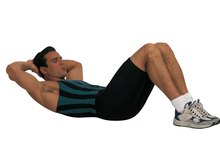Safe Way to Reduce Belly Fat After Hernia Repair
Hernia repair is a very common surgical procedure in the United States. In fact, according to SurgeryChannel.com, over 500,000 of these surgeries are performed each year 2. There are several types of hernias that can occur in both men and women. In women, this is often due to the abdominal muscles tearing open during pregnancy. After abdominal hernia repair, belly fat can still remain. A few options, including exercise and surgery, are available to help you safely reduce that unsightly bulge.
Core Strengthening
Before considering a surgical method to remove your belly fat, try exercise and core-strengthening moves. However, be sure to get your doctor's approval before beginning any abdominal exercise routines. Usually, your doctor will want you to wait a few months before beginning to tone. Enroll in a Pilates or yoga class, as these two practices offer optimum core strengthening. When you begin your class, speak privately with the instructor and tell him or her you have just been cleared from hernia repair. This way, the instructor will watch you closely to make sure you are performing all exercises safely. If you do decide to proceed with surgery later on, exercising will only enhance your results.
- Before considering a surgical method to remove your belly fat, try exercise and core-strengthening moves.
- If you do decide to proceed with surgery later on, exercising will only enhance your results.
Diet
How Do I Get a Flatter Tummy After Liposuction?
Learn More
In addition to exercise, following a nutritious diet plan and reducing your caloric intake can help you shed unwanted belly fat. A great way to track your food consumption is by keeping a journal of everything you eat and drink. This is a great way to make you more conscious of your dietary habits. However, you still need to eat to maintain energy and burn fat. Be sure to consult with your doctor or nutritionist to determine how many calories your body needs to lose weight safely.
- In addition to exercise, following a nutritious diet plan and reducing your caloric intake can help you shed unwanted belly fat.
- Be sure to consult with your doctor or nutritionist to determine how many calories your body needs to lose weight safely.
Surgery
Surgery is usually not recommended until several months after your hernia repair. If you have been following a nutritious diet and core strengthening routine but still have a "pooch" or belly fat that just will not go away, an abdominoplasty (tummy tuck) with liposuction is another option. In an abdominoplasty, the plastic surgeon will tighten your pulled-apart abdominal muscles, remove excess fat through liposuction, and excise extra skin. If you do decide on surgery, be sure to thoroughly research board-certified plastic surgeons in your area. Meet with the doctor for several consultations, and tell her about your hernia surgery. In many cases, abdominoplasty, combined with exercise and diet, is the safest and most effective way to reduce belly fat and flatten your midsection.
- Surgery is usually not recommended until several months after your hernia repair.
- If you have been following a nutritious diet and core strengthening routine but still have a "pooch" or belly fat that just will not go away, an abdominoplasty (tummy tuck) with liposuction is another option.
Related Articles
References
- RealSelf.com: Belly Fat Advice from Surgeons
- SurgeryChannel.com: Hernia Repair
- Harvard Health. (December 2018). Hernia Repair.
- HerniaSurge Group. International guidelines for groin hernia management. Hernia. 2018;22(1):1–165. doi:10.1007/s10029-017-1668-x
- Bittner R, Schwarz J. Inguinal hernia repair: current surgical techniques. Langenbecks Arch Surg. 2012 Feb;397(2):271-82. doi:10.1007/s00423-011-0875-7
- Hassler KR, Saxena P, Baltazar-Ford KS. (Updated June 2020). Open Inguinal Hernia Repair. StatPearls [Internet]. Treasure Island (FL): StatPearls Publishing; 2020 Jan-
- LeBlanch KE, LeBlanc LL, LeBlanc KA. Inguinal Hernias: Diagnosis and Management. Am Fam Physician. 2013 Jun 15;87(12):844-848.
- Berger D. Evidence-Based Hernia Treatment in Adults. Dtsch Arztebl Int. 2016 Mar; 113(9): 150–158.
- Brooks DC. (2020). Overview of abdominal wall hernias in adults. Rosen M, ed. UpToDate. Waltham, MA: UpToDate.
- Society of American Gastrointestinal and Endoscopic Surgeons (SAGES). Guidelines for the Management of Hiatal Hernia. April 2013.
- Johns Hopkins Medicine. Preparing for hernia surgery.
- University of Wisconsin Health. Laparoscopic inguinal hernia repair.
- Johns Hopkins Medicine. What to expect after hernia surgery.
- University of Michigan. (August 2019). Open Inguinal Hernia Repair (Herniorrhaphy, Hernioplasty).
- American College of Surgeons. (2018). Groin Hernia Repair: Inguinal and Femoral.
- Schjøth-Iversen L, Refsum A, Brudvik KW. Factors associated with hernia recurrence after laparoscopic total extraperitoneal repair for inguinal hernia: a 2-year prospective cohort study. Hernia. 2017 Oct;21(5):729-735. doi:10.1007/s10029-017-1634-7
- Chowbey PK, Pithawala M, Khullar R, Sharma A, Soni V, Baijal M. Complications in groin hernia surgery and the way out. J Minim Access Surg. 2006 Sep; 2(3): 174–177. doi:10.4103/0972-9941.27734
- Andresen K, Rosenberg J. Management of chronic pain after hernia repair. J Pain Res. 2018; 11: 675–681. doi:10.2147/JPR.S127820
- Lindmark M, Strigård K, Löwenmark T, Dahlstrand U, Gunnarsson U. Risk Factors for Surgical Complications in Ventral Hernia Repair. World J Surg. 2018; 42(11): 3528–3536. doi:10.1007/s00268-018-4642-6
Writer Bio
Katie Brennan is an award-winning freelance writer in Denver. She realized her passion for prose at age 12, when she published a non-fiction essay in a national book. Brennan has a Bachelor of Arts degree in journalism and English from the University of Iowa.









